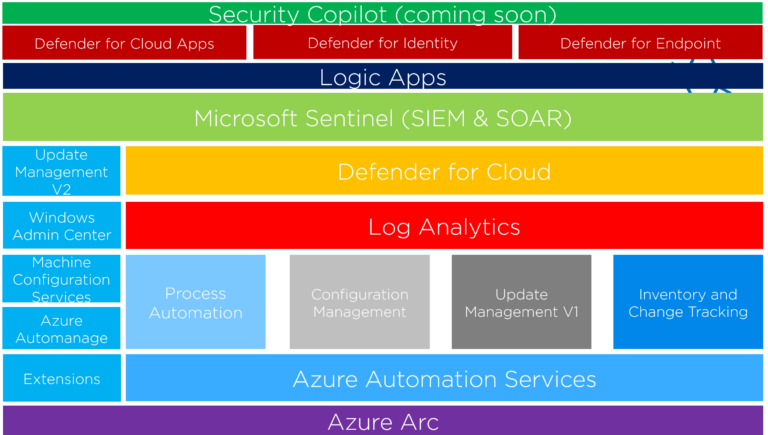Introduction
Azure Arc is a service offered by Microsoft that provides organizations with a unified management platform for their on-premises, multi-cloud, and edge infrastructure. The service allows organizations to manage their servers and applications through a single control plane, making it easier to maintain consistency and control across their environment.
Benefits of Azure Arc
Azure Arc provides a number of benefits to organizations that are looking to manage their infrastructure and applications in a consistent and efficient manner. Some of these benefits include:
- Consistent management: Azure Arc provides a consistent management plane across on-premises, multi-cloud, and edge environments, enabling organizations to manage their infrastructure and applications in a unified manner.
- Hybrid cloud: Azure Arc enables organizations to extend the benefits of the cloud to their on-premises environments, creating a true hybrid cloud experience.
- Kubernetes management: Azure Arc provides a unified approach to manage Kubernetes clusters across on-premises, multi-cloud, and edge environments.
- Cost optimization: Azure Arc helps organizations to optimize their infrastructure costs by reducing the need for multiple management solutions and reducing the complexity of managing infrastructure and applications in a multi-cloud environment.
What is an Azure Arc server?
An Azure Arc server is a server that is registered with the Azure Arc service. This registration allows the server to be managed from the Azure portal, giving organizations the ability to manage their on-premises, multi-cloud, and edge servers in a similar way to how they manage their Azure resources.
How to add servers to Azure Arc?
To add servers to Azure Arc, organizations must first install the Azure Arc agent on each server that they wish to manage. The installation process is straightforward and can be done using a variety of methods, including automation tools and manual installation.
Once the Azure Arc agent has been installed, the server must be connected to Azure and registered with Azure Arc. This process is done through the Azure portal, where organizations can manage and monitor their Azure Arc-enabled servers.
What operating systems are supported by Azure arc?
Azure Arc supports both Windows and Linux operating systems, providing organizations with the ability to manage a wide range of servers and applications. This flexibility makes Azure Arc an ideal solution for organizations with a diverse infrastructure environment.
You can find the supported OS from here – Connected Machine agent prerequisites – Azure Arc | Microsoft Learn
How do I add multiple servers to Azure arc?
Organizations can add multiple servers to Azure Arc using a variety of methods. You can add the servers at scale using the following methods:
- Using a deployment script
- Using Azure Update Management
- Using Az.ConnectedMachine PowerShell module
- Using AzureArcConnectedAgentManagement PowerShell module
- Using Desired State Configuration
- Using a Script feature in Configuration Manager
- Using a Group Policy
- Using Windows Admin Center
- Using a Custom Task Sequence in Configuration
What is the difference between Azure stack and Azure arc?
Azure Stack is a hybrid cloud platform that enables organizations to run Azure services on-premises. It provides organizations with the ability to run Azure services in their own data center, providing increased control and security.
Azure Arc, on the other hand, provides organizations with the ability to manage their on-premises, multi-cloud, and edge servers through a single control plane. This makes it easier to maintain consistency and control across their environment, reducing the complexity of managing multiple servers.
What is Arc-enabled servers?
ARC-enabled servers are servers that are registered with the Azure Arc service. These servers can be managed from the Azure portal, providing organizations with the ability to manage their on-premises, multi-cloud, and edge servers through a single control plane.
What is AWS equivalent of Azure Arc?
There is no exact equivalent to Azure Arc in AWS, however, AWS provides a similar service called AWS Outposts, which allows organizations to run AWS services on-premises. AWS Outposts provides organizations with the ability to run AWS services in their own data center, providing increased control and security.
Why should I use Azure Arc?
Organizations should use Azure Arc to simplify their management of on-premises, multi-cloud, and edge infrastructure. Azure Arc provides a centralized control plane, allowing organizations to manage their servers and applications in a similar way to how they manage their Azure resources. This reduces the complexity of managing multiple servers and ensures that organizations can maintain consistency and control across their environment.
Additionally, Azure Arc provides organizations with the ability to manage their infrastructure in a consistent manner, regardless of where their resources are located. This makes it easier for organizations to manage their on-premises, multi-cloud, and edge infrastructure, reducing the need for multiple management tools and providing a unified management experience.
What is Azure Arc-enabled servers extensions?
Azure Arc-enabled servers extensions are additional components that can be installed on servers managed through Azure Arc. These extensions provide additional functionality and allow organizations to manage specific aspects of their servers in a more efficient manner.
For example, an Azure Arc-enabled server extension could provide organizations with the ability to manage their servers’ network configurations, or to monitor their servers for security and compliance issues. By installing these extensions, organizations can gain greater control and visibility into their infrastructure and ensure that their servers are configured and managed according to best practices.
Azure Arc-enabled server extensions can be managed through the Azure portal, providing organizations with a unified and streamlined management experience. This helps to reduce the complexity of managing multiple servers and ensures that organizations can maintain consistency and control across their environment.
You can read more here about the Azure Arc-enabled servers extension management
What is Azure Arc vs Azure Stack?
Azure Arc and Azure Stack are both hybrid cloud solutions offered by Microsoft, but they serve different purposes. Azure Arc provides organizations with a unified management platform for their on-premises, multi-cloud, and edge infrastructure, enabling them to manage servers and applications through a single control plane. Azure Stack, on the other hand, is an integrated system that enables organizations to run Azure services on-premises, providing a consistent experience between their on-premises environment and the Azure public cloud.
What is the difference between Azure Arc and Azure HCI?
Azure Arc is a management service that allows organizations to manage and govern their on-premises, multi-cloud, and edge servers and applications in a consistent manner using a centralized control plane. Azure HCI (Hyper-Converged Infrastructure) is a Microsoft hybrid cloud solution that integrates compute, storage, and networking into a single, easy-to-manage system. While Azure Arc focuses on providing a unified management platform across environments, Azure HCI aims to simplify the deployment and management of hybrid cloud infrastructure.
Does Azure arc support AWS?
While Azure Arc doesn’t directly support AWS, it does enable organizations to manage resources across different cloud platforms, including AWS, using a centralized control plane. This makes it possible for organizations to manage their AWS resources, such as EC2 instances, consistently alongside their on-premises and other cloud resources.
Does Azure arc work with AWS?
Azure Arc can work with AWS to an extent, as it allows organizations to manage and govern resources across different cloud platforms, including AWS. This provides organizations with the ability to manage their AWS resources consistently, alongside their on-premises and other cloud resources.








